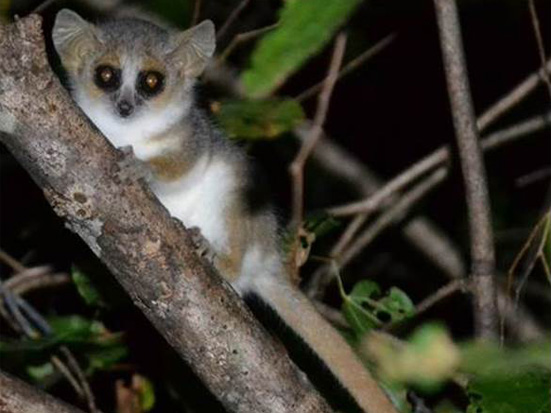Extension of gray-brown mouse lemur (Microcebus griseorufus) activity period in a disturbed forest in southwestern Madagascar
DOI:
https://doi.org/10.4314/mcd.v9i2.6Keywords:
Mouse lemurs, habitat disturbanceAbstract
Habitat disturbances may impact behaviors of animals, including their activity patterns. In southwestern Madagascar, timing of gray - brown mouse lemur activities was investigated in adjacent forests with different levels of human disturbance. Mouse lemurs were encountered more frequently during the second part of the night in the unfenced, more disturbed forest than in the fenced, less - disturbed forest. The extension of mouse lemur activity period in the unfenced forest may be due to differences in forest composition resulting in higher travel costs or a loss of canopy cover which may limit their use of torpor.
RÉSUMÉ
Les perturbations de l’habitat peuvent avoir un impact sur le comportement des animaux, y compris sur leur rythme d’activité. Le déroulement des activités des microcèbes a été étudié dans des forêts adjacentes du Sud - ouest de Madagascar. Une de ces forêts a été protégée du pâturage par une clôture tandis que l’autre ne profitait pas d’un tel dispositif en étant ainsi nettement exploitée par l’Homme et son bétail. Les microcèbes ont été rencontrés plus fréquemment au cours de la deuxième partie de la nuit dans la forêt non clôturée que dans la forêt clôturée. Bien que cette étude n’ait pas permis de détecter des différences dans la disponibilité des insectes ou des fruits, des évaluations plus détaillées de la composition des espèces d’arbres et l’abondance des insectes sont nécessaires pour déterminer l’impact de la qualité nutritionnelle ou de la distribution des ressources sur les rythmes d’activité des microcèbes dans la forêt non clôturée. D’un autre côté, l’allongement de la période d’activité des microcèbes dans la forêt non clôturée peut être lié à une perte de la couverture de la canopée, elle-même à l’origine d’une élévation des températures diurnes dans la forêt non clôturée qui réduirait la durée pendant laquelle les microcèbes pourraient être en torpeur dans cette forêt.
References
Axel, A. C. and Maurer, B. A. 2011. Lemurs in a complex landscape: mapping species density in subtropical dry forests of southwestern Madagascar using data at multiple levels. American Journal of Primatolology 73: 38–52. (doi:10.1002/ajp.20872)
Atsalis, S. 2008. A Natural History of the Brown Mouse Lemur. Pearson-Prentice Hall, Upper Saddle River, NJ.
Atsalis, S., Schmid, J. and Kappeler, P. M. 1996. Metrical comparisons of three species of mouse lemurs. Journal of Human Evolution 31, 1: 61–68. (doi:10.1006/jhev.1996.0049)
Brown, K. A., Johnson, S. E., Parks, K. E., Holmes, S. M., Ivoandry, T., et al. 2013. Use of provisioning ecosystem services drives loss of functional traits across land use intensification gradients in tropical forests in Madagascar. Biological Conservation 161: 118–127. (doi:10.1016/j.biocon.2013.03.014)
Crowley, B. E, Blanco, M. B., Arrigo-Nelson, S. J. and Irwin, M. T. 2013. Stable isotopes document resource partitioning and effects of forest distur¬bance on sympatric cheirogaleid lemurs. Naturwissenschaften 100, 10: 943–956. (doi:10.1007/s00114-013-1094-6)
Ganzhorn, J. U. and Schmid, J. 1998. Different population dynamics of Microcebus murinus in primary and secondary deciduous dry forests of Madgascar. International Journal of Primatology 19, 5: 785–796. (doi:10.1023/A:1020337211827)
Goodman, S. M. 2006. Hunting of Microchiroptera in south-western Madagascar. Oryx 40, 2: 225–228. (doi:10.1017/S0030605306000354)
Harper, G. J, Steininger, M. K., Tucker, C. J., Juhn, D. and Hawkins, F. 2007. Fifty years of deforestation and forest fragmentation in Madagascar. Environmental Conservation 34, 4: 325–333. (doi:10.1017/S0376892907004262)
Irwin, M. T., Wright, P. C., Birkinshaw, C., Fisher, B. L., Gardner, C. J., et al. 2010. Patterns of species change in anthropogenically disturbed forests of Madagascar. Biological Conservation 143, 10: 2351–2362. (doi:10.1016/j.biocon.2010.01.023)
Kobbe, S. and Dausmann, K. H. 2009. Hibernation in Malagasy mouse lemurs as a strategy to counter environmental challenge. Naturwissenschaften 96, 10:1221–1227.
Patel, E. R. 2007. Logging of rare rosewood and palisandre (Dalbergia spp.) within Marojejy National Park, Madagascar. Madagascar Conservation & Development 2, 1: 11–16. (doi:10.4314/mcd.v2i1.44124)
Radespiel, U. 2007. Ecological diversity and seasonal adaptations of mouse lemurs (Microcebus spp.). In: Lemurs: Ecology and Adaptation. L. Gould and M. L. Sauther (eds.), pp 211–234. Springer US.
Raharivololona, B. M. and Ganzhorn, J. U. 2009. Gastrointestinal parasite infection of the gray mouse lemur (Microcebus murinus) in the littoral forest of Mandena, Madagascar: effects of forest fragmentation and degradation. Madagascar Conservation & Development 4, 2: 103–112. (doi:10.4314/mcd.v4i2.48650)
Rasoloarison, R. M., Goodman, S. M. and Ganzhorn, J. U. 2000. Taxonomic revision of mouse lemurs (Microcebus) in the western portions of Madagascar. International Journal of Primatology 21, 6: 963–1019. (doi:10.1023/A:1005511129475)
Rasoazanabary, E. 2011. The human factor in mouse lemur (Microcebus griseorufus) conservation: local resource utilization and habitat disturbance at Beza Mahafaly, SW Madagascar. Unpubl. Ph. D. thesis, University of Massachusetts, Amherst. (http://search.proquest.com/docview/860140823)
Schmid, J. 1998. Tree holes used for resting by gray mouse lemurs (Microcebus murinus) in Madagascar: insulation capacities and energetic consequences. International Journal of Primatolology 19, 5: 797–809. (doi:10.1023/A:1020389228665)
Schmid, J. 2000. Daily torpor in the gray mouse lemur (Microcebus murinus) in Madagascar: energetic consequences and biological significance. Oecologia 123, 2: 175–183. (doi:10.1007/s004420051003)
Schmid, J. and Speakman, J. R. 2000. Daily energy expenditure of the grey mouse lemur (Microcebus murinus): a small primate that uses torpor. Journal of Comparative Physiology B 170, 8: 633–641. (doi:10.1007/s003600000146)
Sussman, R. W. and Ratsirarson, J. 2006. Beza Mahafaly Special Reserve: a research site in southwestern Madagascar. In: Ringtailed Lemur Biology: Lemur catta in Madagascar. A. Jolly, R. W. Sussman, N. Koyama and H. Rasamimanana (eds.), pp 43–51. Springer US.
Wrogemann, D., Radespiel, U. and Zimmerman, E. 2001. Comparison of reproductive characteristics and changes in body weight between captive populations of rufous and grey mouse lemurs. International Journal of Primatology 22, 1: 91–108. (doi:10.1023/A:1026418132281)
Youssouf, J. I. A. and Rasoazanabary, E. 2008. Discovery of Macrotarsomys bastardi at Beza Mahafaly Special Reserve, southwest Madagascar, with observations on the dynamics of small mammal interactions. Madagascar Conservation & Development 3, 1: 31–37. (doi:10.4314/mcd.v3i1.44133)

Downloads
Published
Issue
Section
License
All journal content, except where otherwise noted, is licensed under a creative common Attribution 4.0 International and is published here by the Indian Ocean e-Ink under license from the author(s).


